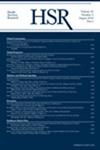Health system resilience during the COVID-19 pandemic: A comparative analysis of disruptions in care from 32 countries
Abstract
Objective
To quantify disruptions in hospitalization and ambulatory care throughout the coronavirus disease 2019 (COVID-19) pandemic for 32 countries, and examine associations of health system characteristics and COVID-19 response strategies on disruptions.
Data Sources
We utilized aggregated inpatient hospitalization and surgical procedure data from the Organization for Economic Co-operation and Development Health Database from 2010 to 2021. Covariate data were extracted from the Organization for Economic Co-operation and Development Health Database, World Health Organization, and Oxford COVID-19 Government Response Tracker.
Study Design
This is a descriptive study using time-series analyses to quantify the annual effect of the COVID-19 pandemic on non-COVID-19 hospitalizations for 20 diagnostic categories and 15 surgical procedures. We compared expected hospitalizations had the pandemic never occurred in 2020–2021, estimated using autoregressive integrated moving average modeling with data from 2010 to 2019, with observed hospitalizations. Observed-to-expected ratios and missed hospitalizations were computed as measures of COVID-19 impact. Mixed linear models were employed to examine associations between hospitalization observed-to-expected ratios and covariates.
Principal Findings
The COVID-19 pandemic was associated with 16,300,000 (95% uncertainty interval 14,700,000–17,900,000; 18.0% [16.5%–19.4%]) missed hospitalizations in 2020. Diseases of the respiratory (−2,030,000 [−2,300,000 to −1,780,000]), circulatory (−1,680,000 [−1,960,000 to −1,410,000]), and musculoskeletal (−1,480,000 [−1,720,000 to −1,260,000]) systems contributed most to the declines. In 2021, there were an additional 14,700,000 (95% uncertainty interval 13,100,000–16,400,000; 16.3% [14.9%–17.9%]) missed hospitalizations. Total healthcare workers per capita (β = 1.02 [95% CI 1.00, 1.04]) and insurance coverage (β = 1.05 [1.02, 1.09]) were associated with fewer missed hospitalizations. Stringency index (β = 0.98 [0.98, 0.99]) and excess all-cause deaths (β = 0.98 [0.96, 0.99]) were associated with more missed hospitalizations.
Conclusions
There was marked cross-country variability in disruptions to hospitalizations and ambulatory care. Certain health system characteristics appeared to be more protective, such as insurance coverage, and number of inputs including healthcare workforce and beds.
What is known on this topic
- Substantial disruptions in health services associated with the coronavirus disease 2019 pandemic have placed a renewed interest in health system resilience.
- While there is a growing body of evidence documenting disruptions in services, there are limited comparative assessments across diverse countries with different health system designs, preparedness levels, and public health responses.
- Learning and adapting from health system-specific gaps and challenges highlighted by the pandemic will be critical for improving resilience.
What this study adds
- All countries experienced disruptions to hospitalizations and surgical procedures with a combined total of 30 million missed hospitalizations and 4 million missed surgical procedures in 2020–2021, but there was marked cross-country heterogeneity in disruptions.
- Countries with greater baseline healthcare workers, insurance coverage, and hospital beds had disproportionately lower disruptions in care.
- National health planning discussions may need to balance health system resiliency and efficiency to avert preventable morbidity and mortality.


 求助内容:
求助内容: 应助结果提醒方式:
应助结果提醒方式:


